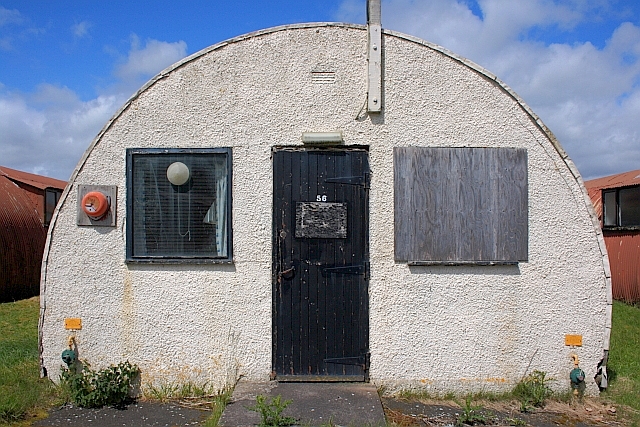
A converted Nissen Hut.*
The camp was situated on Chobham Common; the date it was built is not known. I can only assume that the Ministry of Defence built it in the late 1930s or early 1940s. We do know that prior to 1945 the Canadian Army were in the camp. It was made up mainly of large numbers of Nissan Huts. These were huts with a tin roof, timber frames at each end, and at both ends, two windows and a front rear door whichever way you looked into the hut. The windows were reinforced wire with glass. The interior consisted of one round iron fire with a stack going upwards through the roof. This was mainly a billet for a number of troops, i.e. 20 in all. There were mess halls, built of the same construction, and also concrete huts with proper roofs; these must have been for officers.
At the Brickhill end of the common was a smaller camp and a football pitch. On the hill to the base of the camp was a large water tank that overlooked Brickhill. Electricity, water mains, roads and pathways ran to all huts on the camp, and the main road ran through the camp from Windlesham to the main road leading from Chobham Village to Sunningdale. Down in Brickhill was a small shop that sold most things, mainly cigarettes and tinned foods and vegetables. Chobham village was about two miles away and Sunningdale the same distance. And of course there was Windlesham village, which could be walked to.
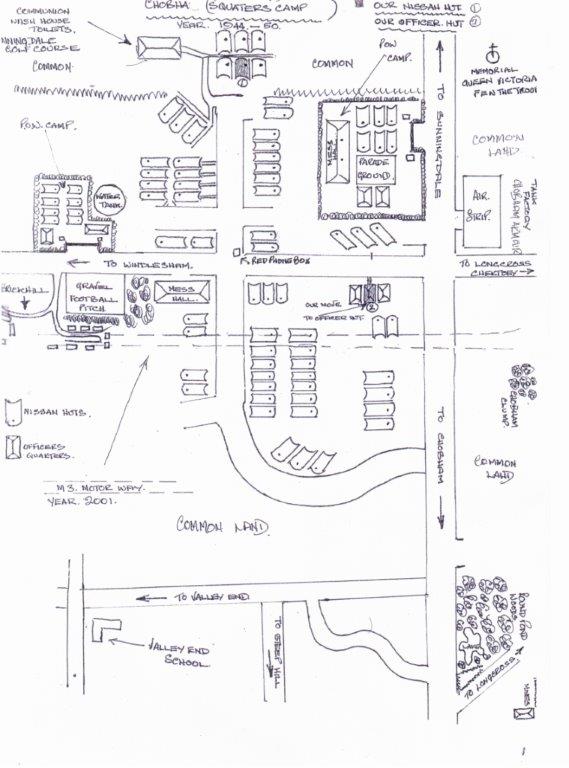
The Camp on Chobham Common. Map by Patrick Rolinson.
My story of Chobham Camp begins after the Canadian Troops had left the camp. The site then became a goldrush for so many families who needed accommodation. I would have been about eight years old, and with my mother, elder brother Jeffrey and my younger sister Mary, we were one of many families that required a place to have of our own.
Mum was informed by her brother Brian that he would go and find us a hut. And he did. He stayed there for several days, keeping guard on the hut until we could get there. It was the middle hut of a group of six, not far from Sunningdale Golf Course. With few possessions, we entered the hut. It was just one big empty space with just a round fireplace, the stack reaching up through the roof.
From this point it was home, but alterations had to be made, such as partitions built with timbers we needed to find. There were several iron beds, so that was a start. We erected the partitions so that there was a room for us boys, one for Mary, and one for Mum, which was where the fire was and where we ate, washed, and if it is the right word, relaxed.
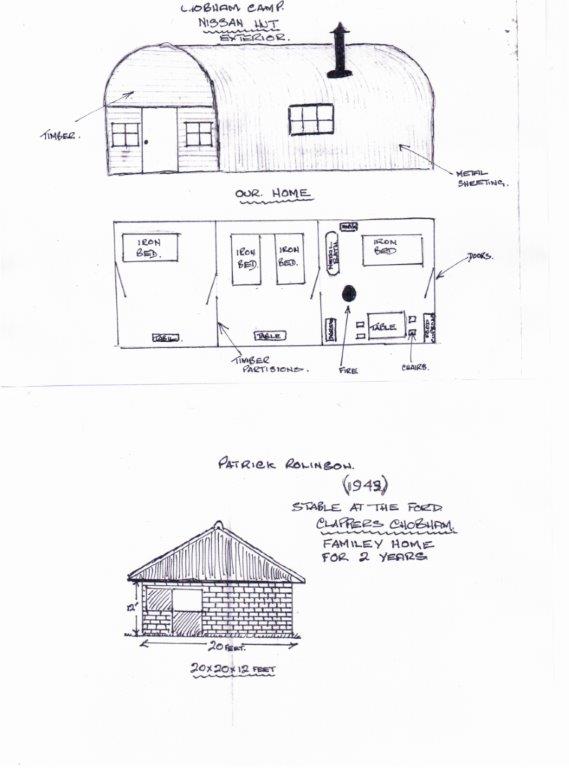
The Nissen Huts on Chobham Common. Diagram by Patrick Rolinson.
We were not alone. The camp was filling up with families and many children of my own age. We, like everyone else, assumed that our stay there would be short-term, but it would not be many years later that we left. No one in authority prevented the families moving in. To us all it seemed we had been given permission. One thing people noticed was that two compounds at the camp were being guarded by British soldiers, and restriction signs were posted for all to see, one by the main Chertsey road above Brickhill and the other next to the main road leading to Sunningdale. Fences were erected, plus some barbed wire, there were entrances that were guarded with sentries and rising pole barriers, and it was not long before we realised why. Large trucks started arriving at the camp, and it was not long before those on board started to disembark. They were lined up on the parade ground, and still more lorries continued to arrive. It was not long before word got round that these were German Prisoners of War. This was a tense moment for us all. One moment we were listening to broadcasts on what we then called a wireless about the war and the terrible things that were happening, and next we had the same people as neighbours.

The Camp on Chobham Common. (Image courtesy Surrey Heath Museum.)
The area depicted on the camp diagram is the landing strip, which is now, in 2010, a picnic area. It became busy with light aircraft landing and taking off. Some passengers looked very important. The runway in those days was very short but that type of aircraft was capable of landing on it. To us young ones, this was great fun.
We were known then as Camp Squatters, and we all got on very well. If you had it, you gave it to those who did not, a bit like the old Eastenders. Life on the Camp was hard but you made the most of it. Schooling was first at the local school, Valley End School, about a mile away. As we grew older we went on to Chobham St Lawrence School, which was a much longer walk. You would start walking to school in the morning, get to Round Pond Woods, and suddenly hear the school bell ringing. With about two more miles to go, you knew you were going to be in trouble. Walking home, especially during the winter months, it was dark, and you still had to walk through Round Pond Woods collecting firewood for the hut stove on the way.
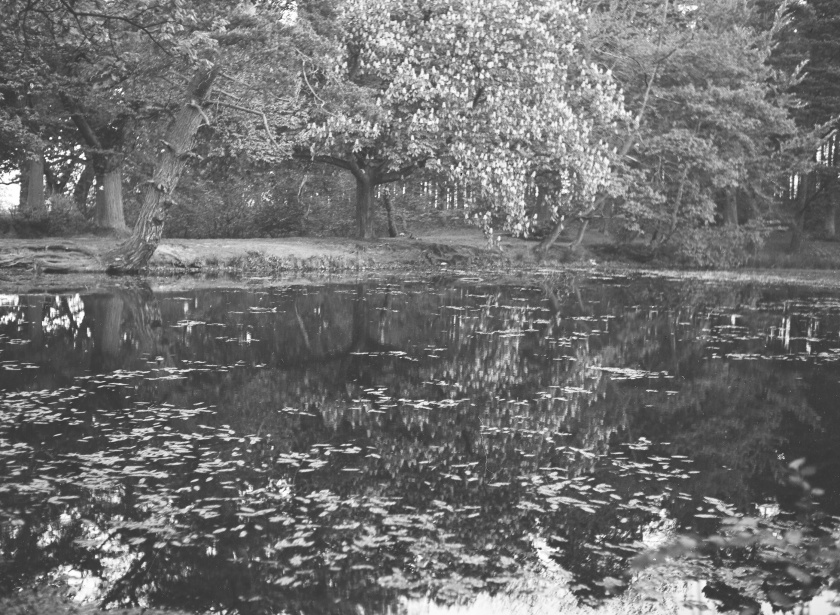
Round Pond. (Photograph by Roy Smithers, image courtesy Mark Stroud.)
Every day our mother would cycle from the camp to a place called Kettlewell Hill just outside Woking, to her job as a domestic servant. The job gave her a little money to help keep us clothed, but it also had its perks, such as food left over by her employers, and not forgetting a small bag of coal she brought back each day for the house. How she managed the trips home in the dark we will never know. I suppose you would say because she was a mother.
I shall always remember one particular night she was returning home. It was very dark. Snow was falling. She approached Round Pond Woods, and had to get off her bike and push it up the hill, head down to avoid the snow. Suddenly a pair of hands grabbed hold of the handlebars. Looking up, petrified, she saw a man dressed in some form of uniform, which she recognised as that of a PoW (Prisoner of war). At that moment a small car arrived, driving up the hill, lights flaring, and the man ran off. The car stopped and the driver asked if she was all right. Shaken, both of them continued their journeys home. Mother’s first thought was to ring her brother in law, Sam, who was on leave from the RAF, and who lived in Chobham. Sam came round and contacted the commanding officer of the PoW camp. He in turn said that the PoWs would parade the next morning so that mum could identify the man.
Next morning, mum, along with Sam, who was dressed in civvies, spent some considerable time walking up and down the men lined up in front of her. But she could not identify anyone. Her words were, “They all look the same.” Sam’s response was to say to her, “pick anyone.” I suppose this was the response of a military man in the RAF who had been fighting these people. Mum refused to do this and that was the end of the matter.

Nissen Huts on Chobham Common. (Image courtesy Surrey Heath Museum.)
Returning to life on the camp: during the last few years I have returned to the camp on several occasions, and found I remembered the layout of the camp very well from all those years ago. I knew where huts used to stand, the roads leading to them, where the pathways and parade grounds of the PoWs used to be, where mess halls used to stand, the communal toilets and bath areas, football pitch, water tower, right down to where eventually the red telephone box stood. They are all there if you know where to look.
Our second hut on the camp was situated on the Chertsey Road end of the camp, approaching the roundabout, which in our time was a crossroads. Approaching today’s roundabout there is a large road sign indicating roads to Sunningdale, Chertsey and Chobham. Right opposite this sign is where we lived all those years ago. The small, but well-worn bridge over the ditch is still there; remove the moss and leaves and you are standing in the rooms as you did many years ago. When my grandchildren were shown this they showed disbelief that this was our home. It is easy to spot where the homes were: on areas where trees cannot grow, just leaves and moss. Some areas are hard to get to now, but when you do find them, you also find the friends that used to be there.
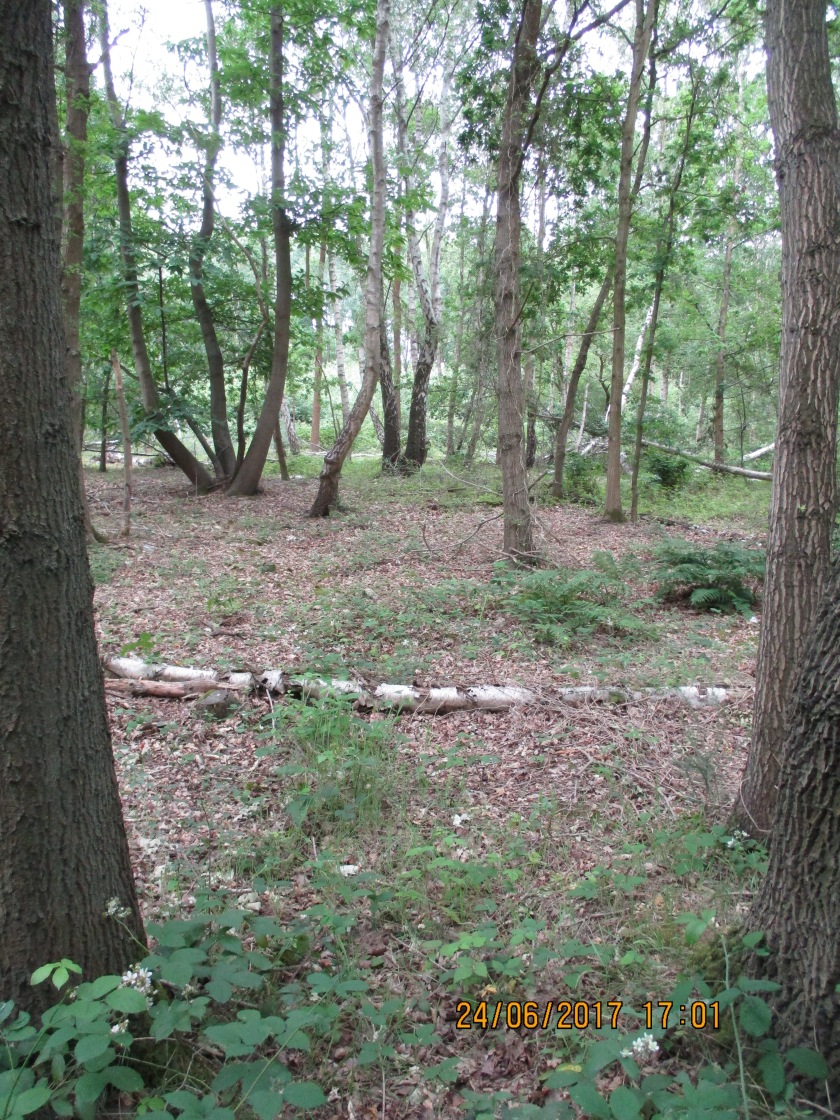
Looking from the “small, but well-worn bridge over the ditch” to the site of the Rolinson’s second hut.
Going back to those days; the football pitch as we knew it is still there today, unchanged. It is at he Brickhill end of the camp, just to the right of the Chertsey road. The only difference is that there are now a couple of iron bars over the entry-places to stop high vehicles getting in. Here we watched the PoWs and guards play football. The pitch was comprised of shingle, and today if you move a clump of grass you can still see the shingle…
1947 was the year of sunshine and snow. The summer was so hot. But the winter was so bad with snow it was six feet deep in places. This made it very difficult to get to the toilets and washroom. At times we would collect snow in a bowl or bucket, melt it, and use it for washing, cooking and even drinking when the pipes froze. One morning I came into mum’s room to make a cup of tea for her and found that due to the warped door, snow had drifted through the gap. I found mum asleep with a huge drift of snow on her and the bed. And so for a few weeks we called her Snow White.
Christmas was upon us. Paper chains we made ourselves. For presents there were apples, oranges, perhaps a book. And then there was the biggest present ever: a knock at the door and we opened it and standing there was a guard and two prisoners with small parcels wrapped in newspaper with pieces of string. In broken English they wished us a happy Christmas. Times like this you wish you had a camera. Mum had a brooch made from some sort of Perspex, the girls rag dolls, and us boys a jigsaw, all made by the Germans. Well, I suppose they had plenty of time to spare, but it was a lovely gesture, a moment never to be forgotten.
Things began to change within the PoW camps, especially the camp on the Sunningdale road. With a guard escort, we were invited into the Mess Hall on several occasions to eat with the PoWs. We were shown photos of their own families and children. When the time came, many of these prisoners remained in the UK, eventually marrying local ladies and finding work as bus drivers. Many years later, we would meet up with these people, either in the village of Chobham or in Woking.

A Nissen hut at Brick Hill. (Image courtesy Surrey Heath Museum.)
Another activity we used to engage in was swimming. Where? Well, also built on the camp, at the Brickhill end, was a large water tower. It was located on the highest part of the camp, overlooking the football field and the smaller PoW camp. As shown in the diagram a ladder was fixed to the outside of the tank leading to the top and a hatchway which could be lifted, with a smaller ladder inside which we would climb down and swim in the clear waters. No health and safety in those times! If we did not swim here we would walk over to Sunningdale golf course where they had a small lake on one of their fairways with a walkway made of timber through the middle which would become a diving board into the water. This is still there today.
Other things made life at the camp easier for us all. For example, a fish and chip van would call round on certain evenings, and a vegetable van as well during days of the week. This made life a little easier for our parents.

One of the roads through the Camp, still to be found opposite Brick Hill.
I suppose if there was a tragic moment in those days it was when we witnessed a large wartime aeroplane crash in the fields above Woodlands Lane, Windlesham. …
Our time in the camp was coming to an end. Many of our parents were rehoused at Brookleys Estate, Chobham, where today many of the children of those parents still live, or even their children. My mother and us children were also rehoused at Brookleys Estate at the end of the road Oakdene. Uncle Sam, whom I mentioned earlier helping mum at the camp, lived with his family in Elm Drive, and another of mum’s sisters lived in Brookleys. My grandparents lived at Little Heath.
Come the summer of 2010 I shall, God willing, go back to the camp…I will once again explore the camp area as in the past, and reminisce at the football ground. Those were the days.
Patrick Rolinson.

The kitchen in a completed temporary house converted from an army Nissen Hut. (Image courtesy of IMW.)
***********************************************
*Nissen Hut, Cultybraggan Camp. (Image courtesy Wikimedia Commons.)
With many thanks to Pat Rolinson.
Also with thanks to Surrey Heath Museum.
***************************************************

Fascinating ! I was born at Brick Hill spent all my childhood here , I remember the camp and always assumed it was a camp for Canadian soldiers then prisoners of war then squatters I never knew that civilian squatters were there alongside pow’s.
LikeLike
My Parents lived in the camp with my two sisters and brother. I came along later when they were given a council house.
LikeLike
Thanks for a great read and the picture you used was my grandad John Henderson and the plane chrashed behind my other grandads house on woodlands lane! My gran was first there when it came down.
LikeLike
this was written by my Uncle Pat, Jeffrey in the story was my Dad, very sad for me to read this as i had no idea how hard it was for my Nan Rose and how my dad and Aunts and Uncle lived. I live in NZ now but this has certainly brought back memories of where i am from, i would love to contact my Uncle Pat as we have lost touch over the years
LikeLike
Hi Pauline, just seen your comment and would like to introduce myself, Pat and Jeffrey are my cousins with Rose being my mums sister. My husband also lived up at the camp in 1947 which is what made me look up this page and was surprised to see that Pat had written this story, I live on the Isle of Wight and Pats daughter also lives here, we have often spoken to each other about family trees but did not know about this story being written. Small world. Pat still lives in Frimley Surrey. Look forward to hearing from you sometime Sue x
LikeLike
Hi Sue I’ve only just found your reply . How lovely to find another family member. Trish and I have been in touch over the years on and off. I’ve tried to contact Uncle Pat and was told he was living in Ireland? I hope you get this reply Would love to catch up ❤️
LikeLike
My mum Vera, dad Cyril Sutton, my brother Brian and I (b Dec 1945) lived in the Nissen camp then from
1948 in Elm Drive, Brookleys. Dad drove tanks at Longcross, mum hairdresser at Seeneys, Chobham. Uncle Aubrey Franklin taught maths at St Lawrence. My first adult home was 2 Weyside Cottages next to Brickmakers Arms. My dad’s cousins Gilbert and Rag ran Sutton’s Bakery and grocers at Burrow Hill, and raced pigeons. My grandparents Owen and Jessie (nee Baigent) lived at 1 Killy Hill. Owen Sutton was a builder. My sister in law Rosie (nee Benham) worked at the metalizing factory on the common. I did paper rounds for Vickys newsagents Windsor Road and my brother and I caddied on Saturdays at Sunningdale.
LikeLike
Do you remember my Mum Dawn Henderson and my dad Graham Ley?
Mum was on the camp in 1947.
LikeLike
I lived as a ‘squatter ‘ in the camp from 1945 – 1949. We had lived in WestEnd with my Grandparents during the war when my Father was in the Army and the only way we could get a council house was to become squatters. I lived in a very basic Nissan hut at the entrance almost opposite Brick lane with my parents and brother and my Mother had two more babies while we lived. The Hut had a cement floor, a stove in the centre of the room and there were two partitions made of plywood fashioned into bedrooms.
The communal toilets were the type that had a main flow system connecting all the cabinets which flushed through the whole building every few minutes with water supplied by the water tower on the hill, for a five year old this was really noisy and scary.
I also attended Valley End School, walking there with other children from the Camp past the Convent which was a long walk for a small girl.
I always think now how hard it must have been for my poor Mother with two babies and two other children no washing machine or disposable nappies, how on earth did she manage?
Eventually we were given a lovely new house in WestEnd with a bathroom and hot water, heaven.
But I have vivid memories of my time in the camp.
LikeLike
i lived in the camp with my 4 brothers and mum whiteley family we moved to the avenue lightwater around 1950
LikeLike
I lived in Chobham Camp from about 1948 -50.( Now in British Columbia Canada ).
I am sure I knew you Pat, your name is very familiar. I lived in two different huts with Mum and Dad, older brother Roy and younger sister Jacqueline and later in Brookleys Estate. I never realized that we were deemed squatters.
The camp was a great place for kids. We used to climb the big water tower and also made hideaways in the small towers by some of the empty huts.
LikeLike
I lived on in the camp from around 1948 -1950 or so, with older brother, younger sister and mum and dad. We then got a council house in Chobham on Brookleys estate. I went to Windlesham school from there.
Some of the family names I remember from the camp days are Smith, Edwards, Crawford, Whitford, Wakeling, Connoly, Rollinson.
It was a great place for kids with miles of common around.
We used to climb the water tower and use the smaller towers by the empty huts for making camps.
Dave Hewson
LikeLike
I have found this very interesting, as I was born in a nissen hut, in a squatters camp, Beaulieu Camp, Avey Lane Waltham Abbey. I have not been able to find out any information about Beaulie camp, or any photos. So it was good to have an insight into what life must have been like for my family. We were lucky to swap the nissan hut for a prefab, which must have been a luxury. The family who swopped with us could not afford the rent for the prefab.
LikeLike
I found the whole history of Longcross so interesting. I done my national service at Longcross 1955-57 driving and testing heavy vehicles and transporting tanks with Chobham armour to Shoeburyness essex to be shot at. Just before I was demobbed, the testing of vehicles were done on site including the hill climb and water pit ready for the military open day display, and my first and only girl friend came to visit the display. We married in 1958 and lost her in 2021 from the covid. Have always wanted to have an insight to the history of Longcross. Many thanks. Mo Steed.
LikeLike
My parents who were my Grandparents lived up there with my mum Patricia and John and Geoff was born their the managed to get the Officers mess which they converted. They used to talk about all the sports teams they had my mum/Nan Margaret (Peggy) Cottingham was in all the teams and always spoke about the amount of friends she made. Richard(Dick) Cottingham was a drummer. They loved the Camp
LikeLike
<
div>My grandad.
<
div dir=”ltr”>
<
blockquote type=”cite”>
LikeLike